Iceland
![]()
This article is about the state. For other meanings, see Iceland (disambiguation).
Template:Infobox State/Maintenance/NAME-German
Iceland (Icelandic Ísland [ˈi:sland] 'ice country') is an island nation in the far northwest of Europe. With about 103,000 square kilometres (of which land area 100,250 and water area 2,750 square kilometres; with fishing zone 758,000 square kilometres), Iceland is - after the United Kingdom - the second largest island state in Europe in terms of area. The main island is the largest volcanic island on earth and is located just south of the Arctic Circle. Iceland is a member of EFTA, the European Economic Area, the Nordic Council and a founding member of NATO.
With its 356,991 inhabitants (as of January 2019), Iceland is the most sparsely populated country in Europe and one of the most sparsely populated countries in the world, with a population density of 3.5 inhabitants per km². Over 60 percent of Iceland's population is concentrated in the capital region of Reykjavík. Human settlement did not begin until the 9th century.
Iceland is one of the leading countries in the world in terms of living standards and per capita income. In the Human Development Index, the country ranked fourth in 2019, on par with Hong Kong.
Population
Demographics
Population distribution
Iceland has 356,991 inhabitants (as of 1 January 2019), of which over 60 percent are concentrated in the capital region. With 3.5 inhabitants per km², Iceland is the most sparsely populated country in Europe and one of the most sparsely populated countries in the world. Only Australia, Namibia, Mongolia, and Western Sahara, which is partially recognized internationally as a state, are more sparsely populated.
For the distribution of the population among the eight regions of Iceland, see Administrative divisions of Iceland.
Population development
| Population development | |
| Year | Population |
| 1950 | 143.000 |
| 1960 | 176.000 |
| 1970 | 204.000 |
| 1980 | 228.000 |
| 1990 | 255.000 |
| 2000 | 280.000 |
| 2010 | 320.000 |
| 2019 | 361.000 |
In contrast to many other western states, the population in Iceland rose steadily until 2008. On 9 January 2006, the 300,000 mark was exceeded. As a result of the financial crisis from 2008 onwards, a slight population decline was recorded; in January 2012, the number of inhabitants was back at 319,575.
Between 1950 and 1990, the proportion of foreigners averaged about 1.5%; by 2003, the rate had risen to 3.5%. Among foreigners at that time, Poles had the largest share at 18.2%, followed by Danes at 8.6%, Filipinos at 6.0%, and Germans at 5.4%. In 2017, 12.5% of the population were migrants.
A major trend in recent years has been rural exodus. Especially more remote areas such as the Westfjords, Snæfellsnes or the extreme northeast suffered from this. Significant parts of the population hoped for better living and earning opportunities in the city, especially in Reykjavík. Later, however, this trend seemed to weaken, see for example Hagstofa Statistical Office on Ísafjörður 1990: population 3498; in 2000: population 2828; in 2010: population 2677, beginning 2019: population 2703.
Religion
→ Main article: Religion in Iceland
The Icelandic State Church is an Evangelical Lutheran community and is supported and protected by the State (Article 62 of the Constitution).
As of 1 January 2015, 73.8% of the population belonged to the state church, 5.9% to various free Lutheran churches. A total of 7.7% belonged to other state-registered denominations, of which the Roman Catholic Church represented the largest share with 3.6% of the population. The neo-pagan religion organized in Ásatrúarfélagið, recognized since 1972, accounted for 0.8%. 0.6% belonged to the Pentecostal Church. This was followed by Buddhists, 0.3% each, and Siðmennt, a non-religious organization affiliated with the International Humanist and Ethical Union, which is legally equal to the religious communities. Iceland's statistical yearbook for 2015 also lists ten other registered religious communities individually, each of which had 0.2% or less of the Icelandic population, including Jehovah's Witnesses (0.2%) and two different Muslim communities, each with 0.1%. Under one heading 'Other smaller registered religious organisations', a variety of organisations are grouped together, each with fewer than 200 members, and together accounting for 0.5 % of the population.
In 2019, only 64% of Iceland's population were still members of the state church, while the Roman Catholic Church had 14,400 members (4%), making it the second largest religious denomination in the country.
7.1% of the population belonged to another (non-state registered) faith community on 1 January 2015 or did not provide any information. 5.6% did not belong to any religious community.
The Icelandic form of church tax, the so-called "congregational fee" (sóknargjald), goes to the state-recognised religious community or secular-humanist group of which the person is registered as a member. A recent development in this context is the so-called Zuism, a movement officially registered as a religious community for the practice of the Sumerian religion in Iceland, which promises its members a refund of the "congregational fee" and recorded a strong increase in membership at the end of 2015.
Language
→ Main article: Icelandic language
The Icelandic alphabet has 32 letters, from A to Á to Æ and finally to Ö. Unlike in German, umlauts such as Ö are treated as independent letters and are therefore not sometimes transcribed and sorted as Oe. Accordingly, the words in the dictionary and also the names in all Icelandic registers, such as the telephone book, are arranged.
Language development and language purism
The Icelandic language is spoken in Iceland. It is a de facto official language, but has never been officially declared as such. It has developed from Old Norse. Even today, Icelanders can read texts from the first centuries after the settlement of the country without major problems, since the written language has hardly changed since the immigration over 1100 years ago. This is explained by the island's isolated location in the North Atlantic. However, the pronunciation has changed during this time.
Icelandic linguistic purism is responsible for the fact that foreign words are usually replaced by Icelandic neologisms. However, this effort to keep the language pure in no way prevents foreign-language equivalents from often appearing alongside the Icelandic term in technical languages.
Names
→ Main article: Icelandic personal name
See also: List of the most common first names in Iceland
In Iceland, first names are the most important part of the name. Family names are rare. Instead, Icelanders bear the patronymic, more rarely matronymic, with the suffix -dóttir ("-daughter") or -son ("-son"). An Icelandic boy who is the son of Jón Einarsson and is to be named Ólafur is given the full name Ólafur Jónsson (son of Jón), and his sister Sigríður would be called Sigríður Jónsdóttir (daughter of Jón).
These names are also retained upon marriage. In families, first names are often passed on. To avoid confusion, children are often given several names. If one introduces oneself with "My name is ...", the counter question "Whose son/daughter?" often comes. This also asks about the family. Many Icelanders can trace their ancestry back over 1000 years to the time of the land grab.
Writing and grammar
Icelandic still has one runic letter, Þ, and three letters derived from the Latin alphabet: Ð, Æ and Ö.
If the German language already has extensive word and sentence structure rules, they are even more complex in Icelandic. This is explained by the fact that, due to centuries of isolation on a remote island, Icelandic has essentially preserved an ancient linguistic form.
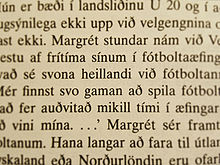
Excerpt from a modern Icelandic text
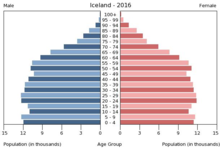
Iceland has one of the youngest populations in Europe
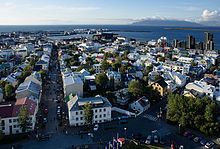
Reykjavík, view from the tower of Hallgrímskirkja to the harbour
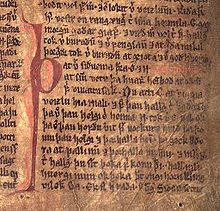
Medieval manuscript Möðruvallabók
Politics
→ Main article: Political system of Iceland
State structure
Iceland has been an independent parliamentary democratic republic since 17 June 1944 (see Constitution of the Republic of Iceland). The Althing, the legislature, consists of 63 deputies. The judiciary in Iceland is divided into two tiers. The district courts form the lower level. The High Court, Hæstiréttur, the supreme court, also functions as the constitutional court. The head of state is the President of Iceland, Guðni Th. Jóhannesson since 2016. The affairs of state are conducted by the Prime Minister of Iceland.
Since the 2013 general election, the country has been governed by a coalition of the Progress Party (peasant centre) and the liberal-conservative Independence Party, initially as the Sigmundur Davíð Gunnlaugsson cabinet and since the resignation of Prime Minister Sigmundur Davíð Gunnlaugsson (Progress Party) in early April 2016 as the Sigurður Ingi Jóhannsson cabinet.
Early elections were held in autumn 2016, the 54th parliamentary election in Iceland in 2016, after which it initially proved difficult to form a government. Since 11 January 2017, a coalition government of the Independence Party and the liberal parties Viðreisn and Björt framtíð under Prime Minister Bjarni Benediktsson existed with the Bjarni Benediktsson Cabinet (2017). It fell apart as Björt framtíð announced on 15 September 2017 that it would leave the coalition. Therefore, early elections were held again on 28 October 2017. Since 30 November 2017, a coalition of the Left-Green Movement, the Progress Party and the Independence Party has governed as the Katrín Jakobsdóttir cabinet.
Parties
See also: List of political parties in Iceland
In the mid-1970s, the four-party system that traditionally prevailed in Iceland was broken up. The four state-supporting parties until then were:
- the Independence Party (Sjálfstæðisflokkur, SF, conservative),
- the Progress Party (Framsóknarflokkur, FF, liberal),
- the Social Democratic Party of Iceland (Alþýðuflokkurinn, AF, social democratic) and
- the People's Alliance (Alþýðubandalagið, AL, socialist).
The attempt to unify all left-wing parties led to the emergence of two new parties, the:
- social democratic and pro-European alliance (Samfylkingin, Sf) and the
- Left-Green Patriotic Movement (Vinstri hreyfing-Grænt framboð, VG).
The Social Democratic Alliance also absorbed the Women's Alliance, which in 1983 was the first women's party in the world to enter a national parliament, where it was consistently represented until the merger.
The following parties are also currently represented in parliament: The pirate party Píratar (since the 2013 election), the liberal and pro-European party Viðreisn (since the 2016 election), the populist Flokkur fólksins (since the 2017 election), and the Centre Party, founded in 2017 as a spin-off of the Progress Party. From 2013 to 2017, representatives of Björt framtíð ("Bright Future") (pro-European, liberal) were also members of the Althing.
Political indices
| Political indices published by non-governmental organisations | ||||
| Index name | Index value | Global rank | Interpretation aid | Year |
| Fragile States Index | 17.8 from 120 | 174 from 178 | Stability of the country: very sustainable | 2020 |
| Democracy Index | 9.37 from 10 | 2 from 167 | Full democracy | 2020 |
| Freedom in the World Index | 94 from 100 | - — | Freedom status: free | 2020 |
| Press freedom ranking | 15.37 from 100 | 16 from 180 | Satisfactory situation for press freedom | 2021 |
| Corruption Perception Index (CPI) | 75 from 100 | 17 from 180 | 0 = very corrupt / 100 = very clean | 2020 |
Trade unions
There are several sectoral trade unions and a confederation of trade unions (ASÍ) in Iceland. More than 90 % of the dependent employees are organised. Although on a declining trend, the cooperative system plays an almost unique role in the world on the island. Almost all important areas of life (pensions, special holiday payments, health care, children's and youth leisure facilities downstream from schools, cultural events, fishing vessel pools and their revenue distribution, ...) are organised, partly or completely, on a cooperative basis.
Foreign Policy
Iceland is a member of the following organizations: FAO (since 1945), United Nations (since 1946), NATO (since 1949), Council of Europe (since 1949), Nordic Council (since 1952), EFTA (since 1960), OECD (since 1961), UNESCO (since 1964), OSCE (since 1975/1992), West Nordic Council (since 1985/1997), Barents Sea Council (since 1993), EEA (since 1994), WTO (since 1995), Council of the Baltic Sea States (1995), Arctic Council (since 1996), since October 2002 again member of the International Whaling Commission, besides these memberships there is a defence agreement with the USA (since 1951).
See also: Iceland and the European Union
Management structure
→ Main article: Administrative division of Iceland
Politically, Iceland is divided into eight regions: Höfuðborgarsvæðið, Suðurnes, Vesturland, Vestfirðir, Norðurland vestra, Norðurland eystra, Austurland and Suðurland. The eight regions are divided (traditionally, but not administratively) into 22 sýslur (syssel, roughly counties) and 20 county municipalities (eight kaupstaðir, seven bæir, one borg, and four others). At the lowest administrative level, there are 76 sveitarfélög (municipalities) (as of 2010), including the eight kaupstaðir (as of 2005).
Cities
See also: List of cities in Iceland
Around 93% of Iceland's population lived in cities in mid-2008, with 118,918 of the country's 321,857 inhabitants living in the capital Reykjavík alone (2013 projection). The high level of urbanisation can be traced back to the ongoing rural exodus that began in Iceland in the 20th century.
However, the majority of municipalities outside the capital area are now experiencing population growth again. Of the eight regions in Iceland, five now have stable positive population growth. Only the majority of municipalities in the Northwest Iceland region continue to lose inhabitants.
Communities
Iceland has 74 municipalities, the largest of which are listed below.
|
|
1 in the agglomeration of Reykjavík
Military
See also: Military situation of Iceland
Iceland does not officially have its own military. The Icelandic Coast Guard, with its base in Reykjavík, is responsible for coastal protection. It is equipped with three patrol boats, a surveillance plane and several helicopters. The helicopters take over SAR tasks and rescue flights for the population in the event of storms or accidents. Iceland recruits civilian contingents for UN and NATO missions (Íslenska friðargæslan) from police and coastal defence forces. Iceland has been a founding member of NATO since 1949. In the event of an alliance conflict, it has declared its readiness to provide medical assistance.
Within the framework of NATO (command: ISCOMICE), the USA had stationed the so-called Iceland Defense Force in Keflavík with approximately 1,650 soldiers. The force comprised 960 marines, 600 US Air Force soldiers and 80 from the US Marine Corps. The American troop presence dated back to as early as 1941. During World War II, the soldiers served to secure supply routes. Later, during the Cold War, the U.S. military used the strategically important island as an anti-submarine warfare base, in case of conflict with the Soviet Union.
In 1951, the USA committed itself to the defence of Iceland in a bilateral defence agreement. The support of the Icelandic Coast Guard by the five stationed helicopters and the patrols in Icelandic airspace by four F-15 fighter aircraft played a major role in this. The stationing most recently cost the United States of America around 260 million US dollars per year.
On 19 March 2006, the US decided unilaterally and surprisingly for Iceland to withdraw its forces. On 30 September 2006, the last US soldiers stationed in Iceland left the country. 600 Icelanders lost their jobs at the military base. However, the United States continues to guarantee military protection to the Icelandic government under the bilateral treaty. An Office of National Defense Affairs was established to provide U.S.-directed electronic air surveillance. To ensure a physical military presence, regular air patrol campaigns (two to three times a year) have been arranged with several NATO partners. Friendly squadrons are then billeted on the former American base. For the first time, a French squadron with Mirage fighters came to Iceland in April 2008.
The governments in Oslo and Reykjavík agreed on the Norwegian Air Force taking over security, surveillance and rescue tasks in peacetime. The Norwegian Army recruits volunteers for military service in Iceland on a small scale. For the surveillance of the Icelandic coast, Reykjavík has agreed to cooperate with the Danish Navy.
Although Iceland does not have its own armed forces, it was represented in the coalition of the willing in 2003.
State budget
In 2016, the national budget comprised expenditures of the equivalent of 7.911 billion US dollars, which were offset by revenues of the equivalent of 10.350 billion US dollars. This resulted in a budget surplus of 12.2% of GDP.
Government debt in 2016 was US$10.6 billion, or 53% of GDP. Iceland has been able to restructure its public finances in recent years.
In 2006, the share of government expenditure (as % of GDP) of the following sectors was:
- Health: 9.1 %
- Education: 7.6 % (2004)
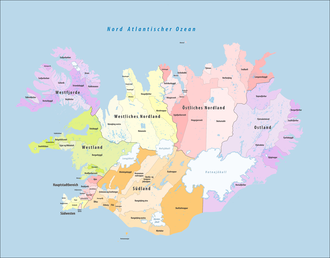
Administrative divisions Iceland

Countries with diplomatic missions in Iceland
.jpg)
Seat of the Icelandic Parliament Althing
Questions and Answers
Q: Where is Iceland located?
A: Iceland is an island country in the North Atlantic, between Greenland and Norway.
Q: How far away from Greenland and Norway is Iceland?
A: Iceland is 301 kilometers east of Greenland and 1001 kilometers west of Norway.
Q: What is the population of Iceland?
A: There are about 329,100 people who live in Iceland.
Q: What is the area of Iceland?
A: The area of Iceland is 103,000 km².
Q: Was Iceland ever a possession of Denmark?
A: Yes, it was formerly a possession of Denmark.
Q: Is Iceland culturally considered to be part of Europe?
A: Yes, it is culturally considered to be part of Europe.
Q: Does the name "Iceland" have any meaning in Icelandic language?
A: Yes, "Iceland" translates to Ísland in Icelandic language.
Search within the encyclopedia